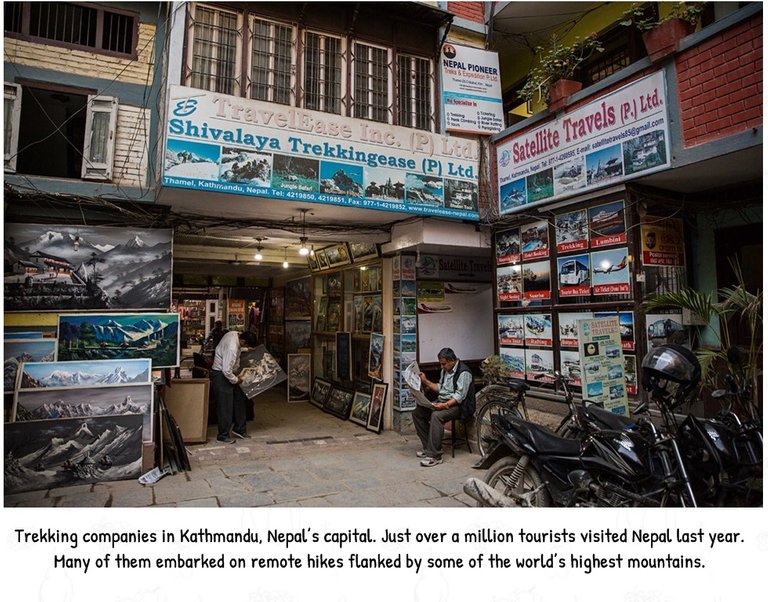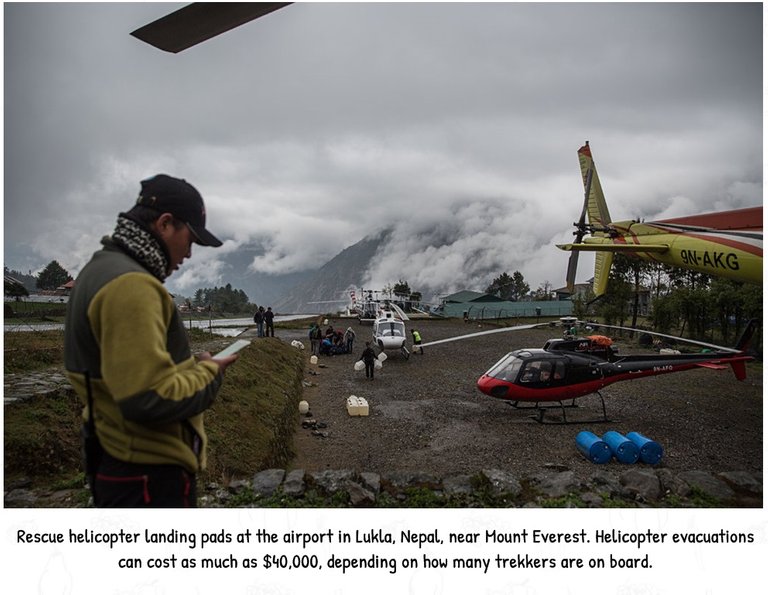International insurance companies on Friday, January 25th, threatened to end travel coverage to Nepal if the government did not crack down on elaborate helicopter rescue scams that target foreigners trekking near Mount Everest and other high-altitude peaks.
Last year, investigations by the Nepali government and Traveller Assist, a medical assistance company based in Ireland, found that some trek operators, guides, helicopter companies and even doctors and hospitals had conspired to bilk millions of dollars from insurance companies by pushing for emergency mountainside evacuations for minor illnesses, or when simpler treatment options were available.
The guides preyed on trekkers when they were most vulnerable — trudging up remote trails, cold, wet, sick, confused and miles from any well-serviced towns.
The Nepali government found evidence that some guides went as far as intentionally making hikers ill by spiking their food with large amounts of baking soda, which can cause vomiting, diarrhea and other ailments, and then calling for an emergency helicopter evacuation.
These evacuations can cost as much as $40,000 each, depending on how many trekkers are on board, and insurance companies are often stuck with the bill.
Jonathan Bancroft, the managing director of Traveler Assist, which represents three insurance underwriters, questioned why the government has yet to file charges against 17 Nepali companies accused of fraud or tax evasion.

In a letter delivered to Nepal’s minister of tourism on Friday, Mr. Bancroft wrote that if the government did not bring charges against these companies, all of which are reportedly still in business, the insurance underwriters would cut off coverage for Nepal starting from Feb. 15.
“To be clear, this is an ultimatum!” Mr. Bancroft wrote. “If our clients stop issuing travel insurance policies in Nepal, it won’t be long until other insurers do the same. This will have a devastating effect on the tourism industry in Nepal, and your country’s reputation.”
The three insurance underwriters, which control 23 travel insurance brands that cover over 100,000 travelers to Nepal annually, were not identified in the letter. Their market share is sizable: Just over a million tourists visited Nepal last year. Many of them embarked on remote hikes flanked by some of the world’s highest mountains.
Most trekking operators in Nepal are upstanding and see client safety as a key concern. Aware of the risks associated with traveling to high altitudes, many visitors buy travel insurance costing several hundred dollars, opting for plans that include emergency helicopter rescues. To ensure proper acclimatization on the way to places like Everest Base Camp, which sits more than 17,000 feet above sea level, hikes are spread over days.
But according to government officials, insurers and employees in Nepal’s tourism industry, some mountain guides earn commissions from trekking operators by pressuring inexperienced hikers to be flown back to Kathmandu, the capital, at the first minor signs of altitude sickness.
Trekkers are dissuaded from exploring other options, like taking medicine, going to clinics along the hiking route or simply descending a few thousand feet, which solves many cases of altitude sickness. As a scare tactic, the common cold or fatigue are sometimes purposefully mischaracterized as acute mountain sickness, which can be deadly in an advanced stage.
In Kathmandu, hospitals involved in the fraud perform unnecessary tests, exaggerate symptoms and even hold on to trekkers’ passports to prevent them from leaving.
In another version of the scam, healthy hikers agree to a helicopter rescue in exchange for a cut of money or a free ride off the trail.
When bills are submitted for insurance claims, helicopter companies and hospitals inflate prices for their services. Multiple insurance claims are submitted for a single helicopter ride when more than one trekker is on board.
Some trekking operators, which act as brokers and take a percentage of rescue fees from helicopter companies, make more money through evacuations than they do charging for hikes. The typical profit margin for each hiker heading to Everest might be just a few hundred dollars. Participating in the scam could net operators thousands of dollars in kickbacks.
The investigation last year by Traveler Assist found evidence of fraud by four hospitals and 13 helicopter, charter and rescue companies. The separate investigation by Nepal’s government identified most of those same companies. A few dozen more trekking companies are thought to be involved.
“To say this is a complex problem is an understatement,” said Danny Kaine, head of assistance at Traveller Assist. “Fraud and corruption in the helicopter rescue industry in Nepal are so ingrained in some companies. It has become an accepted way of doing business.”
Insurance companies initially struggled to track the fraud, though it has been occurring since at least the early 2010s. But over the last few years, the number of insurance claims from Nepal shot up dramatically.
Alarmed at the increase, travel insurance companies created internal blacklists of Nepali helicopter companies and hospitals, posted advisories warning trekkers of the scam and raised premiums.
Traveler Assist found that about 1,600 helicopter rescues had occurred in Nepal from January to August 2018, out of which 35 percent were considered fraudulent, costing insurers some $4 million in losses.
In September, Nepal’s government introduced a new monitoring program that required companies to submit bills to the department of tourism to ensure that they were genuine.
But Mr. Bancroft, in his letter, wrote, “Not a single charge has been laid.” From September to December 2018, Traveler Assist determined that about 15 percent of some 1,600 rescues during that period were fraudulent.

In interviews, Nepali officials blamed each other.
Ghanshyam Upadhaya, a spokesman for the ministry of tourism, said his office had sent their findings to other ministries — health, home, finance and civil aviation — but was waiting to hear back.
Ramkrishna Subedi, a spokesman for the Home Ministry, shifted responsibility back to the Tourism Ministry to “take action.”
Another government official who was formerly at the Tourism Ministry, speaking on condition of anonymity, said that nothing had been done on the issue.
Penalties could spill out of the country.
Madhab Prasad Bhattarai, a Nepali lawyer, said corporate fraud was a criminal offense in Nepal, and tax evasion, which some companies are also accused of, could be considered a criminal or civil offense. Both are punishable by fines and jail time.
But because fraud was committed against travel insurance companies based outside Nepal, the cases could be escalated to law enforcement agencies in countries like the United States or Britain. Foreign travel insurance companies that continue to entertain claims from Nepali companies charged with fraud could also be investigated, said Mr. Kaine of Traveler Assist.
“It’s a vicious circle,” he said. “Some insurers and assistance providers are facilitating the fraud by paying large invoice amounts without any questions being asked. This makes our job all the more difficult.”
Let’s hope that all will be resolved on time for the Everest climbing season that starts in the end of March, beginning of April.
Alex
Photos
Credit - Lauren DeCicca for The New York Times
Source
Plagiarism is the copying & pasting of others work without giving credit to the original author or artist. Plagiarized posts are considered spam.
Spam is discouraged by the community, and may result in action from the cheetah bot.
More information and tips on sharing content.
If you believe this comment is in error, please contact us in #disputes on Discord
Hi! I am a robot. I just upvoted you! I found similar content that readers might be interested in:
https://www.nytimes.com/2019/01/25/world/asia/nepal-everest-insurers-fraud.html